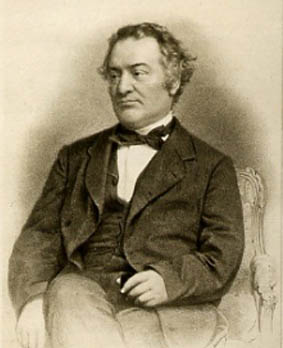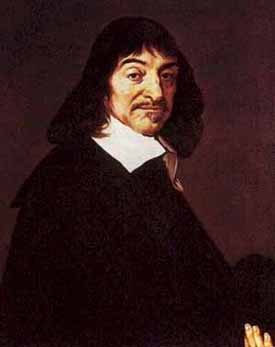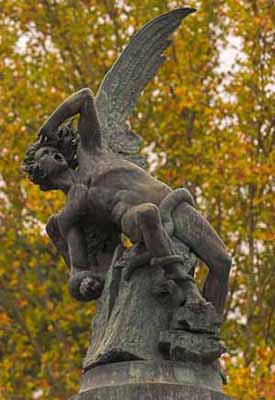 |
Faith under Attack
Subjectivism Destroying the Catholic Faith
Lyle J. Arnold, Jr.
We are told that there are only two options in this life, good and evil (Genesis 2: 17). St. Louis de Montfort teaches us that each option redounds to a race: "the race of the Holy Virgin or the race of the Devil." God decreed that there is but one enmity, between the Devil and "the Woman," and they are eternal enemies (Gen 3: 15). A raging war exists between the two, and Our Lady's hatred against Satan is total and relentless. (1) This truth holds today and for all time.

Counter-revolutionary Louis Veuillot:
No middle road for Catholics |
Commenting on it, the erudite Catholic polemicist Louis Veuillot of the 19th century affirmed: "For Catholics to follow their times is a disgrace, worse than that of a king abdicating his kingship. How can such liberal Catholics be taken seriously? Either they will come back to the fullness of their Faith or they will go over to the enemies of the Faith, but they cannot remain suspended in between." (2)
The choice, as Veuillot so categorically states, is "either ... or." If a person opts for a third choice, it will contain elements of error, because the "two powers are mutually exclusive." For Veuillot the war is between "Revelation and Revolution." Only truth and error exist, outside of which is the "third way" which contains the virus of ecumenism. (3) This third way is complicated, will lead to confusion and, finally, to "full-blooded apostasy."
Brazilian intellectual Plinio Corrêa de Oliveira concurs. In his well-known work, Revolution and Counter-Revolution, he adopts Veuillot’s basic thesis, but redefines it for modern man and expresses it in terms of a perennial war being waged between Revolution and Counter-Revolution. The continuous decline of Christian Civilization is caused by the various revolutions in History: Humanism and the Renaissance, the Pseudo-Reformation, the French Revolution, the Communist Revolution and the current Cultural Revolution (4).
Prof. Plinio clearly states that Catholics must choose a side in the R-CR war and eschew the center position. He points out that the most crucial point in this fight today is taking place in the spiritual arena: "The center, the most sensitive and truly decisive point in the fight between the Revolution and the Counter-Revolution has shifted from the temporal society to the spiritual one. This center has now come to be the Holy Church. Within its fabric, on the one side are the progressivists, crypto-communists and pro-communists, and on the other side are the anti-progressivists and the anti-communists." (5)
Following that same thesis of Veuillot and Oliveria, Atila S. Guimarães offers an insight of vital importance in Vol. VI of his 11-volume series on Vatican II. (6) In Will He Find Faith? he aims to pinpoint the root of the errors in progressivist philosophy. But, as he notes, that progressivist thinking is hard to catch because it swims in a tangled swamp filled with subjectivism, relativism and anti-Scholasticism. (7) Because the presumptuous and confused thoughts are "many" in this satanic pool, he must identify the muddled ideas that seek to distort the one, universal and abstract Catholic Faith.
The many errors in Modern Philosophy
The task Guimarães sets himself is Herculean, because the enemy wants to replace immutable Catholic truth – in its pure simplicity – with one that evolves, conforming to the ethos and Zeitgeist of our present age. The anti-Scholastic errors of the 14th century produced bad fruit that rotted into Idealism, Phenomenology and Existentialism. From this putrid heap of ideas, Guimarães distinguishes the many variant errors and shows how they shape and serve the Progressivist heresy. The term ‘many’ here is significant, because we know the Devil is legion (Mk 5) and has uncountable faces to mask his lies.
But whence the many errors of philosophy? What are its source and channels of operation? Guimarães provides an answer in a section called “The Cartesian Revolution,” demonstrating the pivotal role played by René Descartes in modern philosophy. Guimarães' indictment shows how both the method of the Cartesian system - based on doubt – was a bad innovation, as well as the role of intuition, which affirms that only what we conceive clearly is true. With this Descartes launched the sabotage of Scholastic philosophy.
From the standpoint of metaphysics, Descartes’ doctrine abandons the first principles as the starting point of Philosophy. From the standpoint of orthodoxy, Cartesian principles were officially rejected by the Church as opposed to Theology. And because Descartes relies on the subject, instead of the Thomistic methodical inquiry that starts with the object, the proverbial can of worms was opened. Behold the source of the ‘many.’ (8)
Once the subject became the focus of inquiry, this subjectivism sprouted so many different ‘isms’ that they seemed to divide and mutate simultaneously. This explains the fact that today we have not one, but ‘many’ ways of approaching the putative truth. But what exactly was it that generated this massive Cartesian error, which touched so profoundly on fundamental theology and philosophy, and has been the characteristic of modern philosophy since Descartes?
The answer is that the Catholic Faith must embrace - among other faculties - the spiritual, and Descartes rejected this. Cartesian principle cast doubt on everything except for the intellectual reality.
Descartes’ fundamental subjectivism
A résumé of the man’s life is helpful for understanding of what happened.

Descartes' obsession with ego led to a fundamental subjectivism |
The philosopher, mathematician, scientist and writer René Descartes (Latinized to Renatus Cartesius) was born in France in 1596, but spent much of his life in the Dutch Republic. He died of a cold in 1650 at the age of 53 in Sweden, where he was the tutor to Queen Christina. He spent his death-watch not in the calm confidence and hope for Our Lady's assistance at the door of eternity, but with "his eyes wandering," his spirit in a "rage."
There were two reasons for his anger. The first, because the physician called to save his life was one who disagreed with his philosophy. Thus Descartes ordered him out: Descartes never forgot an enemy. The second cause of his rage was because death was approaching, and his greatest endeavor in life was to avoid it. His whole career had been “a kind of chess match with death,” and for a long time he had convinced himself that he had the upper hand. (9)
When death came, because he was nominally a Catholic in a Protestant nation, he was buried in a graveyard used mainly for un-baptized infants. Later his remains were taken to France for burial. Because he was a darling of the French Revolution, his bones were disinterred once again, this time for burial in the Pantheon (from the Greek "all the gods") in Paris, among the ‘great French thinkers.’ In 1663 the Pope placed his works on the Index of Forbidden Books.
At age 10, Descartes was sent off to the Jesuit college of La Fleche in Anjou. He had been a sickly child, but under the Jesuit regime he became robustly healthy. But his childhood infirmities stuck in his mind, and he developed an obsession with physical heath. It can rightly be said that his obsession was much like that of the modern man.

Descartes rebelled against Catholic Scholasticism as Lucifer against God |
From an early age his thinking centered on the physical and natural, grounded in "his desire to solve the puzzle of the body, to cure disease, and to lengthen human life – especially his own. He clearly stated that "the preservation of health has always been the principal end of my studies" (emphasis in the original). (10) Thus we see a man dedicated to medicine and physical health, but who is ironically known mainly for his revolutionary innovations in Philosophy.
Descartes problem began with his ego. His method of reasoning, in fact, began with "I" (ego in Latin). “I think, therefore I am - Cogito ergo sum.” He made the same mistake as Lucifer. He began with himself. This basic philosophical error has been called "the first sin" of philosophy, but it could well be called a mega-sin. Many scholars have noted the underlying immanentist premise in his thinking - since man has an innate idea of God, then man constitutes part of God. Therefore, to know about Him, we need only reflect on ourselves (11). It is easy to see how Descartes' ego led to this confused conclusion.
Having disregarded both Aristotle and St. Thomas Aquinas, he found himself one night in Germany in a “stove,” a tiny room intensely heated by a ceramic furnace. There he experienced hallucinations he would later call a "vision." (12)
Considering the great damage the Cartesian principles caused to Christendom, one can licitly ask just what or who was at the base of this “vision.” Afterwards, basing his philosophy on self, he wrote his Discourse on Method. His pompous and inflated ego led him to the conclusion that his ideas "insofar as they are clear and distinct, cannot fail to be true."
Objectivism leads to salvation
Thus, the catastrophe came from focusing on the subject instead of the object. The object of life is salvation, a spiritual quest. We are called first and foremost to know and love God. But following Descartes’ logic, we find that it is impossible for us to know any reality that exists outside the mind. Everything becomes subject to a man’s experience of reality, and not to an objective truth.
There is no longer one truth, but ‘many.’
In this muddle, the Catholic position is nonetheless clear. We must fight against the progressivist heresy in the Church; we must fight against subjectivism in Philosophy. This must be an active, not a passive fight, because the passive position is the third way that leads to “full-blooded apostasy,” as Veuillot called it. To avoid this, to remain under the banner of the Holy Virgin, we must be intransigent in defending the truth and fighting error.
At times it can seem difficult, but we have a formidable Patroness. St. Louis de Montfort tells us (13) that if we go to Our Lady and ask for her help in this battle, she will take it as an obligation of justice on herself to preserve us in the Faith.
1. St. Louis De Montfort, True Devotion to the Blessed Virgin Mary (Bay Shore, NY: The Montfort Fathers, 1950), p. 35-36.
2. Louis Veuillot, The Liberal Illusion (Kansas City: Angelus Press, 2005), pp. 59, 71-73.
3. The term used by Veuillot was "Eclecticism," which is identical to Ecumenism. In a footnote, the translator defines it as “a philosophical combining of beliefs … reducing all systems of human thought into one." Ibid.
4. Plinio Correa de Oliveira, Revolution and Counter-revolution
5. Ibid.
6. Four volumes of the collection titled Eli Eli, Lamma Sabacthani? are available from Tradition in Action: In the Murky Waters of Vatican II, Desire to Destroy-I, Desire to Destroy-2, and Will He Find Faith? Three Special Editions to the Collection are also available: Quo Vadis, Petre?, Previews of the New Papacy, and Vatican II, Homosexuality and Pedophilia.
7. Atila Sinke Guimaraes, Will He Find Faith? (Los Angeles: TIA, 2007), .p. 39.
8. Ibid., pp. 52-54.
9. Russell Shorto, Descartes' Bones, (NY: Doubleday, 2008), pp. 2, 3.
10. Ibid., p. 4.
11. A. S. Guimaraes, Will He Find Faith?, p. 53; Fr. Chad Ripperger, "Immanentism and the Ecclesiological Crisis,” Latin Mass Magazine, Winter 2007, p. 20.
12. Shorto, Descartes’ Bones, pp. 14 -17.
13. True Devotion to Mary, "Fifth Truth," pp. 63-65.

Posted on January 9, 2009

Related Articles of Interest
 Nietzsche, Herald of the Revolution’s Pride Nietzsche, Herald of the Revolution’s Pride
 Interview: Will He Find Faith? Interview: Will He Find Faith?
 The Collection: Eli, Eli Lamma Sabacthani? The Collection: Eli, Eli Lamma Sabacthani?
 Philosophy Then and Now Philosophy Then and Now
 How to Distinguish the True Faith from Heresy How to Distinguish the True Faith from Heresy
 Zarathustra and Vatican II Zarathustra and Vatican II
 Revolution and Counter-Revolution: An Overview Revolution and Counter-Revolution: An Overview

Related Works of Interest
|
|
Faith under Attack | Religious | Home | Books | CDs | Search | Contact Us | Donate

© 2002-
Tradition in Action, Inc. All Rights Reserved
|
 |
|